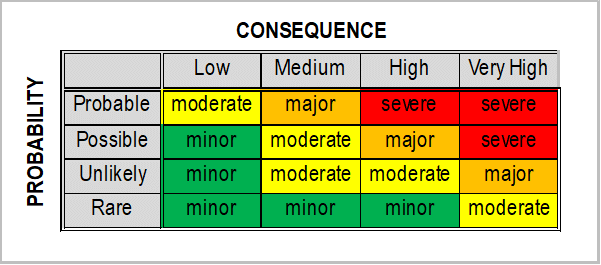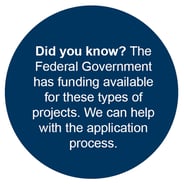How Environmental Risk Identification Helped the City of Victoria Prioritize Action
Ageing infrastructure and changing climate are just a couple of the many hazards municipal governments face as they plan, design, build, operate and maintain infrastructure and services. As these hazards become more severe, so does the level of risk associated with these hazards. In addition, the daily operations of municipalities can create environmental hazards such as waste, discharges or emissions that could unknowingly harm their community or the surrounding environment.
Knowing the environmental hazards and risks to municipal water distribution, stormwater drainage, wastewater collection and treatment, garbage collection and disposal, transportation systems, and public amenities is good practice - but how are hazards identified? What are the risks? And most importantly, how do municipalities prioritize action? Answering these questions is especially important given the need to balance political pressures, diverse priorities, and of course, municipal budgets going forward.
The answers lie in a systematic and collaborative approach to identify and assess environmental risks and hazards. The City of Victoria’s Department of Engineering and Public Works (EPW) recently relied on Morrison Hershfield’s expertise in environmental risk management to help them do just that. Using their decades of experience, Morrison Hershfield developed a Risk Assessment Program that was backed by hard data. This program was able to help the City:
- Understand their business activities and associated environmental hazards.
- Perform a risk assessment to define the magnitude of the identified risks and the associated potential environmental effects.
- Prioritize mitigation strategies and manage resource allocation to reduce the identified risks.
- Assess new hazards and priorities moving forward by equipping them with a thorough report and tool.
Taking the first steps to managing risk
In order to identify environmental hazards, Morrison Hershfield first needed to become familiar with the EPW operations. This process started by developing and submitting a questionnaire designed to assist EPW staff to think about environmental hazards associated with their work. A sample of the questions is shown in the table below. The questionnaire asked about the responsibilities and daily activities of each department including any emissions, wastes or other discharges that are produced from their works. Josie Gilson and Al Strang, two of Morrison Hershfield’s environmental planners, then met with EPW supervisors and reviewed the questionnaire responses and discussed the day-to-day activities of their crews. Al Strang, noted “Spending time at the beginning of the project with EPW staff, so that we could learn about their work, was a key element of the project’s success.” Rory Tooke, the City’s Manager of Sustainability and Asset Management added, “Involving our supervisors at an early stage led to a higher level of acceptance and understanding of the process we were undertaking.”
Table: A sample of questions used to identify environmental hazards.
Identifying, prioritizing and mitigating risk
Once Morrison Hershfield understood the activities of the department, a record of all identified risks was developed that included the environmental hazards, current controls used to manage each hazard, and the potential environmental effects. Hazards were considered within the context of the changing global climate such as rising sea level and more intense storms, and factored in how those changes may affect City infrastructure. Morrison Hershfield assessed the level of risk by classifying the probability and consequences of each hazard as minor, moderate, major or severe (see the risk matrix below). Using these metrics an overall level of risk associated with each hazard was identified. Once drafted, the classification of the identified risks and hazards was reviewed with supervisors and their manager. The review was a critical piece to check accuracy of the content and gain input into the risk analysis.

In order to identify systemic risks within the department, Morrison Hershfield identified activities carried out by multiple sections within EPW, and conducted additional analyses. Since these activities are common to many sections within the department, they occur frequently and implementing department-wide controls to manage them will reduce EPW’s overall risks substantially.
Moving forward
Following the review with supervisors and managers, the recorded risks were presented to senior EPW management staff to discuss the findings and finalize the project. The result of this project was the development of a tool that EPW staff will use to:
- Systematically prioritize their efforts to reduce environmental risks and address hazards.
- Track implementation of new environmental controls or infrastructure upgrades that mitigate risk.
- Re-evaluate risks on a regular basis.
This is an important tool for EPW and the City of Victoria, and, as Rory Tooke emphasized, “Addressing our risk activities systematically based on a robust process is important to the Department, and with Morrison Hershfield’s support we are able to show decision makers where resources should be allocated in order to most effectively reduce our exposure. In addition, the tool allows us to easily show how actions taken have helped to reduce our risks.”
If you are interested in having a risk management tool tailored for your operation,  Morrison Hershfield can help. We will work with you to develop a repeatable, defendable environmental risk management tool which identifies risks, and prioritizes the greatest level of liability to your organization, then help find a sustainable solution to eliminate or mitigate those risks.
Morrison Hershfield can help. We will work with you to develop a repeatable, defendable environmental risk management tool which identifies risks, and prioritizes the greatest level of liability to your organization, then help find a sustainable solution to eliminate or mitigate those risks.
For information on how Morrison Hershfield can assist you with Risk Management Identification and Plans, contact Al Strang.
Posts by Topic
Topics
- 5G (1)
- ACEC (3)
- Active Transportation (5)
- AFP/P3 (6)
- Alberta (5)
- Anniversary (1)
- approvals (1)
- Architect (2)
- Atlanta (2)
- Awards (62)
- Biophysical Sciences (1)
- Board of Directors (1)
- Bridge Rehabilitation (3)
- Building and Facilities Engineering (2)
- Building Energy (25)
- Building Envelope (48)
- Building Science (65)
- Calgary (2)
- Canada 150 (1)
- Canstruction (2)
- Capabilities (1)
- Carbon emissions (2)
- Carbon Pathfinder Tool (1)
- Carson Awards (5)
- Charity (13)
- Climate Adaption (7)
- climate change (7)
- Code and Life Safety (8)
- Commercial Buildings (4)
- Commissioning (11)
- Construction (2)
- Construction Administration (5)
- Consulting Engineering (1)
- Critical Facilities (33)
- CSR (24)
- Culture (5)
- Dallas (1)
- Data Center (22)
- Data Center Commissioning (9)
- Data Center Design (12)
- design (9)
- Design Build (1)
- DSSP (1)
- edgecomputing (1)
- edgetechnologies (1)
- Edmonton (4)
- Electrical (24)
- Electrical engineering (8)
- Energy (8)
- Engineers Canada (5)
- Environmental (36)
- Environmental Compensation (1)
- Environmental Impact Assessment (3)
- environmental planner (3)
- Environmental Planning (5)
- ETFE (1)
- Event (12)
- Existing Buildings (6)
- Facade Engineering (4)
- Ferry Docks (2)
- FIDIC (3)
- fisheries biologist (1)
- Flood Mapping (1)
- Florida (1)
- Forensic Investigation (1)
- Fundraising (11)
- garage (2)
- Gender Diversity (8)
- Gender Intelligence (3)
- Geometric Design (2)
- Government (14)
- Hospitality (1)
- Houston (4)
- Hydro (2)
- India (1)
- industrial (4)
- Infrastructure (28)
- Innovation (1)
- interchange (1)
- IWD (2)
- IWD2021 (1)
- Land Development (8)
- Landfill (4)
- Manitoba (1)
- MCF (3)
- Mechanical (21)
- Mechanical Engineering (1)
- MEP (1)
- mission critical (10)
- Moncton (1)
- Motivational MH'er (1)
- Multi-Use Pathways (1)
- Municipal Infrastructure (5)
- municipal solid waste (2)
- MUP (1)
- New Brunswick (1)
- New Hire (17)
- New Role (3)
- Newsroom (121)
- northern communities (2)
- NVTC (2)
- ontario (1)
- Operations Consulting (8)
- Ottawa (2)
- Panel (3)
- People (124)
- Project Management (6)
- QAP (1)
- Rail (1)
- Reconstruction (1)
- regulatory (1)
- Renewable Energy (2)
- resiliency (3)
- Risk Management (1)
- Roads and Highways (3)
- Salt Lake City (1)
- Seattle (1)
- Security (4)
- Social Responsibility (30)
- Solid Waste (11)
- solid waste management (5)
- St Johns (2)
- Stantec (1)
- Structural (14)
- Sustainability (23)
- Telecom (9)
- Texas (1)
- Toronto (13)
- towers (1)
- Traffic Assessment (2)
- Transfer Station (1)
- Transit (13)
- Transit Consultant (3)
- Transit Infrastructure (3)
- Transit Planning (2)
- Transportation (30)
- Transportation Engineering (8)
- transportation structures (2)
- TTC (1)
- Vancouver (6)
- Virginia (2)
- Washington DC (3)
- Waste to Energy (2)
- Water & Wastewater (8)
- Water Resources (3)
- wellfield (1)
- wellness challenge (1)
- Whistler (1)
- Whitehorse (1)
- Wireless (2)
- Women in Engineering (5)
- Yukon (5)
